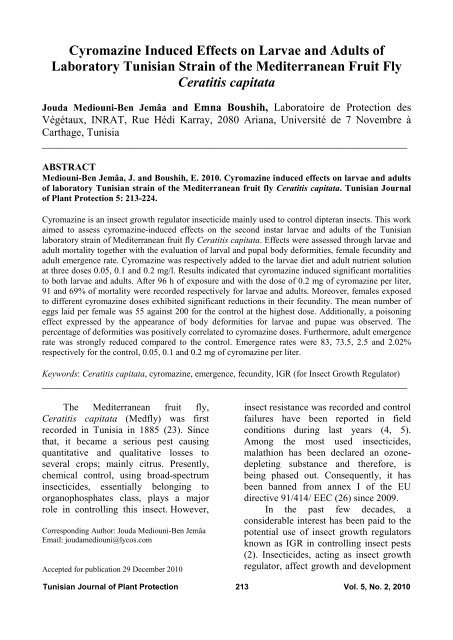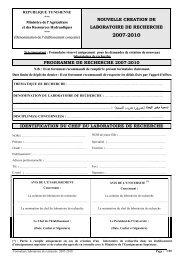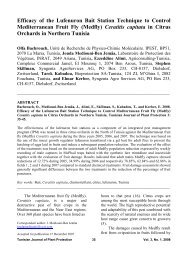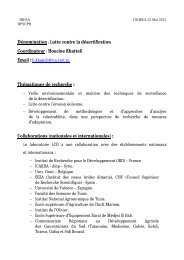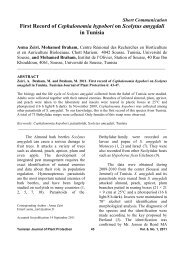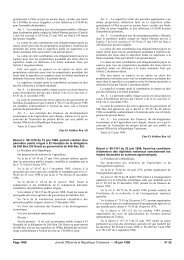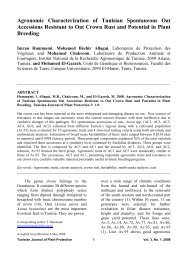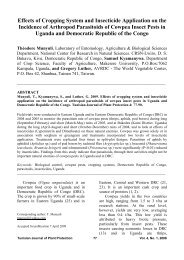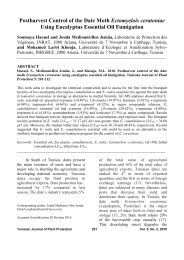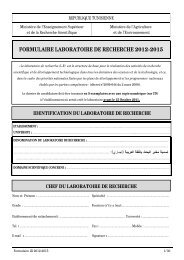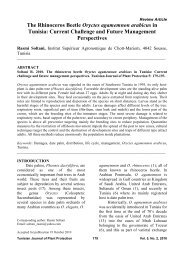Cyromazine Induced Effects on Larvae and Adults of ... - Iresa
Cyromazine Induced Effects on Larvae and Adults of ... - Iresa
Cyromazine Induced Effects on Larvae and Adults of ... - Iresa
You also want an ePaper? Increase the reach of your titles
YUMPU automatically turns print PDFs into web optimized ePapers that Google loves.
<str<strong>on</strong>g>Cyromazine</str<strong>on</strong>g> <str<strong>on</strong>g>Induced</str<strong>on</strong>g> <str<strong>on</strong>g>Effects</str<strong>on</strong>g> <strong>on</strong> <strong>Larvae</strong> <strong>and</strong> <strong>Adults</strong> <strong>of</strong><br />
Laboratory Tunisian Strain <strong>of</strong> the Mediterranean Fruit Fly<br />
Ceratitis capitata<br />
Jouda Mediouni-Ben Jemâa <strong>and</strong> Emna Boushih, Laboratoire de Protecti<strong>on</strong> des<br />
Végétaux, INRAT, Rue Hédi Karray, 2080 Ariana, Université de 7 Novembre à<br />
Carthage, Tunisia<br />
__________________________________________________________________________<br />
ABSTRACT<br />
Mediouni-Ben Jemâa, J. <strong>and</strong> Boushih, E. 2010. <str<strong>on</strong>g>Cyromazine</str<strong>on</strong>g> induced effects <strong>on</strong> larvae <strong>and</strong> adults<br />
<strong>of</strong> laboratory Tunisian strain <strong>of</strong> the Mediterranean fruit fly Ceratitis capitata. Tunisian Journal<br />
<strong>of</strong> Plant Protecti<strong>on</strong> 5: 213-224.<br />
<str<strong>on</strong>g>Cyromazine</str<strong>on</strong>g> is an insect growth regulator insecticide mainly used to c<strong>on</strong>trol dipteran insects. This work<br />
aimed to assess cyromazine-induced effects <strong>on</strong> the sec<strong>on</strong>d instar larvae <strong>and</strong> adults <strong>of</strong> the Tunisian<br />
laboratory strain <strong>of</strong> Mediterranean fruit fly Ceratitis capitata. <str<strong>on</strong>g>Effects</str<strong>on</strong>g> were assessed through larvae <strong>and</strong><br />
adult mortality together with the evaluati<strong>on</strong> <strong>of</strong> larval <strong>and</strong> pupal body deformities, female fecundity <strong>and</strong><br />
adult emergence rate. <str<strong>on</strong>g>Cyromazine</str<strong>on</strong>g> was respectively added to the larvae diet <strong>and</strong> adult nutrient soluti<strong>on</strong><br />
at three doses 0.05, 0.1 <strong>and</strong> 0.2 mg/l. Results indicated that cyromazine induced significant mortalities<br />
to both larvae <strong>and</strong> adults. After 96 h <strong>of</strong> exposure <strong>and</strong> with the dose <strong>of</strong> 0.2 mg <strong>of</strong> cyromazine per liter,<br />
91 <strong>and</strong> 69% <strong>of</strong> mortality were recorded respectively for larvae <strong>and</strong> adults. Moreover, females exposed<br />
to different cyromazine doses exhibited significant reducti<strong>on</strong>s in their fecundity. The mean number <strong>of</strong><br />
eggs laid per female was 55 against 200 for the c<strong>on</strong>trol at the highest dose. Additi<strong>on</strong>ally, a pois<strong>on</strong>ing<br />
effect expressed by the appearance <strong>of</strong> body deformities for larvae <strong>and</strong> pupae was observed. The<br />
percentage <strong>of</strong> deformities was positively correlated to cyromazine doses. Furthermore, adult emergence<br />
rate was str<strong>on</strong>gly reduced compared to the c<strong>on</strong>trol. Emergence rates were 83, 73.5, 2.5 <strong>and</strong> 2.02%<br />
respectively for the c<strong>on</strong>trol, 0.05, 0.1 <strong>and</strong> 0.2 mg <strong>of</strong> cyromazine per liter.<br />
Keywords: Ceratitis capitata, cyromazine, emergence, fecundity, IGR (for Insect Growth Regulator)<br />
__________________________________________________________________________<br />
The Mediterranean fruit fly,<br />
Ceratitis capitata (Medfly) was first<br />
recorded in Tunisia in 1885 (23). Since<br />
that, it became a serious pest causing<br />
quantitative <strong>and</strong> qualitative losses to<br />
several crops; mainly citrus. Presently,<br />
chemical c<strong>on</strong>trol, using broad-spectrum<br />
insecticides, essentially bel<strong>on</strong>ging to<br />
organophosphates class, plays a major<br />
role in c<strong>on</strong>trolling this insect. However,<br />
Corresp<strong>on</strong>ding Author: Jouda Mediouni-Ben Jemâa<br />
Email: joudamediouni@lycos.com<br />
Accepted for publicati<strong>on</strong> 29 December 2010<br />
insect resistance was recorded <strong>and</strong> c<strong>on</strong>trol<br />
failures have been reported in field<br />
c<strong>on</strong>diti<strong>on</strong>s during last years (4, 5).<br />
Am<strong>on</strong>g the most used insecticides,<br />
malathi<strong>on</strong> has been declared an oz<strong>on</strong>edepleting<br />
substance <strong>and</strong> therefore, is<br />
being phased out. C<strong>on</strong>sequently, it has<br />
been banned from annex I <strong>of</strong> the EU<br />
directive 91/414/ EEC (26) since 2009.<br />
In the past few decades, a<br />
c<strong>on</strong>siderable interest has been paid to the<br />
potential use <strong>of</strong> insect growth regulators<br />
known as IGR in c<strong>on</strong>trolling insect pests<br />
(2). Insecticides, acting as insect growth<br />
regulator, affect growth <strong>and</strong> development<br />
Tunisian Journal <strong>of</strong> Plant Protecti<strong>on</strong> 213 Vol. 5, No. 2, 2010
<strong>of</strong> the pre-adult life stages <strong>of</strong> insects, <strong>and</strong><br />
are effective against many insects (25).<br />
<str<strong>on</strong>g>Cyromazine</str<strong>on</strong>g>, N-cyclopropyl-1,3,5-<br />
triazine-2,4,6-triamine, is an atypically<br />
substituted s-triazine, which acts as an<br />
insect growth regulator used as a chitin<br />
synthesis inhibitor for fly c<strong>on</strong>trol in cattle<br />
manure, field crops, vegetables <strong>and</strong> fruits<br />
(7, 34). It is an effective larvicide against<br />
a number <strong>of</strong> dipteran <strong>and</strong> lepidopteran<br />
species (20, 29). <str<strong>on</strong>g>Cyromazine</str<strong>on</strong>g> has a good<br />
activity against many dipteran species,<br />
especially when it is orally administered<br />
to larvae which usually exhibit a wide<br />
range <strong>of</strong> different morphological<br />
abnormalities (3, 15, 27, 35).<br />
<str<strong>on</strong>g>Cyromazine</str<strong>on</strong>g> is characterized by a<br />
rapid stiffening <strong>of</strong> the cuticle, affecting<br />
mostly larvae <strong>of</strong> Diptera (9, 14, 18).<br />
Reynolds <strong>and</strong> Blakey (29) have shown<br />
that an early acti<strong>on</strong> <strong>of</strong> cyromazine leads<br />
the cuticle to become less extensible<br />
when subjected to simple c<strong>on</strong>stant load<br />
extensi<strong>on</strong> tests. They have suggested that<br />
the cyromazine-induced reducti<strong>on</strong> in<br />
cuticle extensibility may be resp<strong>on</strong>sible<br />
for the other symptoms <strong>of</strong> pois<strong>on</strong>ing <strong>and</strong><br />
hence may be the primary effect <strong>of</strong> the<br />
insecticide. Moreover, cyromazine<br />
induces gross deformities manifest in<br />
larvae <strong>and</strong> pupae <strong>of</strong> dipteran insects (3,<br />
9), <strong>and</strong> also reduces egg laying <strong>and</strong> egg<br />
hatch when fed to Lucilia cuprina adult<br />
(38). Moreover, Alam et al. (2) clearly<br />
dem<strong>on</strong>strated that cyromazine, ingested<br />
by female flies, is incorporated into eggs<br />
<strong>and</strong> inhibits larval development in the<br />
first generati<strong>on</strong>.<br />
<str<strong>on</strong>g>Cyromazine</str<strong>on</strong>g> is also effective as<br />
foliar spray in horticultural crops against<br />
leafminers (Liriomyza spp.) <strong>and</strong> various<br />
other insects, including fleas, thrips, <strong>and</strong><br />
coleoptera (18, 32). It is reported to be a<br />
main translaminar pesticide used to<br />
c<strong>on</strong>trol respectively the pea leafminer<br />
Liriomyza huidobrensis <strong>and</strong> the<br />
serpentine leaf miners (L. trifolii) (13, 17,<br />
30, 37). <str<strong>on</strong>g>Cyromazine</str<strong>on</strong>g> was used because it<br />
is harmless to parasitoids (6, 31).<br />
Recently, there is an increasing trend<br />
am<strong>on</strong>g <strong>on</strong>i<strong>on</strong> growers in New York to<br />
manage <strong>on</strong>i<strong>on</strong> maggot using a<br />
combinati<strong>on</strong> <strong>of</strong> cyromazine seed<br />
treatment <strong>and</strong> chlorpyrifos (Lorsban 4E,<br />
Dow AgroSciences LLC) in furrow<br />
treatments (28). The Medfly, C. capitata<br />
was reported am<strong>on</strong>g the susceptible<br />
species to cyromazine applicati<strong>on</strong>s (35).<br />
<strong>Larvae</strong> when reared <strong>on</strong> an artificial diet<br />
supplemented with different<br />
c<strong>on</strong>centrati<strong>on</strong>s <strong>of</strong> cyromazine, suffer from<br />
severe developmental disrupti<strong>on</strong><br />
depending <strong>on</strong> larval age <strong>and</strong> durati<strong>on</strong> <strong>of</strong><br />
exposure (11, 36). Symptoms <strong>of</strong><br />
pois<strong>on</strong>ing include body malformati<strong>on</strong>s,<br />
such as swelling <strong>of</strong> the integument <strong>and</strong><br />
el<strong>on</strong>gati<strong>on</strong> <strong>of</strong> the larvae, as well as<br />
inhibiti<strong>on</strong> <strong>of</strong> larval growth, increase <strong>of</strong><br />
larval mortality <strong>and</strong> a lower pupati<strong>on</strong> <strong>and</strong><br />
adult emergence rate. Furthermore, Budia<br />
<strong>and</strong> Viňuela (10) reported that the<br />
delivery <strong>of</strong> cyromazine could affect the<br />
reproducti<strong>on</strong> <strong>and</strong> larval development <strong>of</strong><br />
C. capitata.<br />
The present work aims to assess<br />
cyromazine effects <strong>on</strong> larvae <strong>and</strong> adults<br />
<strong>of</strong> Tunisian Medfly strain reared under<br />
laboratory c<strong>on</strong>trolled c<strong>on</strong>diti<strong>on</strong>s.<br />
MATERIALS AND METHODS<br />
Insect. <strong>Larvae</strong> <strong>of</strong> C. capitata were<br />
reared <strong>on</strong> an artificial diet based <strong>on</strong> wheat<br />
bran, sucrose <strong>and</strong> yeast (Table 1). The<br />
wheat bran was first sterilized at 120°C<br />
for two hours. After that, all solid<br />
ingredients were weighed <strong>and</strong> mixed until<br />
a homogenous c<strong>on</strong>sistency was reached.<br />
Liquid yeast <strong>and</strong> hydrochloric acid were<br />
then added. To avoid bacterial <strong>and</strong> fungal<br />
c<strong>on</strong>taminati<strong>on</strong>s, sodium benzoate <strong>and</strong><br />
nipagin were added to the diet.<br />
The rearing culture was kept in a rearing<br />
room at 27 o C ± 1 o C, 75 ± 5% R.H <strong>and</strong><br />
under c<strong>on</strong>tinuous light.<br />
Tunisian Journal <strong>of</strong> Plant Protecti<strong>on</strong> 214 Vol. 5, No. 2, 2010
Insecticide. <str<strong>on</strong>g>Cyromazine</str<strong>on</strong>g> (registered<br />
trademark Trigard 75, Syngenta<br />
AgroServices AG, Switzerl<strong>and</strong>) was<br />
tested against C. capitata. Trials were<br />
c<strong>on</strong>ducted <strong>on</strong> the sec<strong>on</strong>d instar larvae <strong>and</strong><br />
new emerged adult flies. Trigard 75 WP<br />
was dissolved in distilled water at<br />
respective doses <strong>of</strong> 0.2, 0.1 <strong>and</strong> 0.05 mg/l.<br />
Technical ingredient, cyromazine, was<br />
orally administered in the drinking water<br />
<strong>and</strong> incorporated into the diet respectively<br />
to newly emerged adult flies <strong>and</strong> larvae.<br />
For adult flies, experiments were carried<br />
out into circular plastic boxes (∅ = 20<br />
cm). Each box c<strong>on</strong>tains 50 adults (25♂ +<br />
25♀). Trials were replicated 10 times to<br />
improve precisi<strong>on</strong>. Ten cages with<br />
untreated drinking water served as<br />
c<strong>on</strong>trol. For larvae, experiments carried<br />
<strong>on</strong> with 20 larvae, were performed in<br />
Petri dishes (∅ = 9 cm) c<strong>on</strong>taining 100 g<br />
<strong>of</strong> diet. The experiment was replicated 10<br />
times. Ten Petri dishes c<strong>on</strong>taining<br />
untreated diet were used as c<strong>on</strong>trol.<br />
The effects <strong>of</strong> three doses <strong>of</strong><br />
cyromazine <strong>on</strong> larvae <strong>and</strong> adult<br />
mortalities were assessed at 24, 48, 72<br />
<strong>and</strong> 96 h after treatment. The dose 0.2<br />
mg/l corresp<strong>on</strong>ded to the recommended<br />
dose <strong>of</strong> Trigard 75 by the registrati<strong>on</strong><br />
pesticide service <strong>of</strong> the Tunisian Ministry<br />
<strong>of</strong> Agriculture. Moreover, female<br />
fecundity was determined at different<br />
doses. In additi<strong>on</strong>, body deformities <strong>of</strong><br />
larvae <strong>and</strong> pupae together with adult<br />
emergence rate were evaluated.<br />
Table 1. Compositi<strong>on</strong> <strong>of</strong> C. capitata diet:<br />
quantities per 1000 g <strong>of</strong> diet (12)<br />
Ingredient<br />
Quantité<br />
Wheat bran<br />
550.0 g<br />
Sucrose<br />
340.0 g<br />
Sodium Benzoate<br />
2.5 g<br />
Nipagin<br />
2.5 g<br />
Yeast (liquid)<br />
1000 ml<br />
Hydrochloric acid<br />
20 ml<br />
Statistical analyses. Adult <strong>and</strong><br />
larval mortalities were calculated at 24,<br />
48, 72 <strong>and</strong> 96 h after treatment using<br />
Abbott formula (1) expressed by<br />
C − T , where C = rate <strong>of</strong> Medfly<br />
Tunisian Journal <strong>of</strong> Plant Protecti<strong>on</strong> 215 Vol. 5, No. 2, 2010<br />
TR =<br />
C<br />
x 100<br />
mortality in the c<strong>on</strong>trol field, T = rate <strong>of</strong><br />
Medfly mortality in the treated field <strong>and</strong><br />
TR = rate <strong>of</strong> populati<strong>on</strong> reducti<strong>on</strong>. Results<br />
were expressed as percentage <strong>of</strong><br />
mortality.<br />
Biological parameters, like<br />
fecundity, body deformities <strong>of</strong> larvae <strong>and</strong><br />
pupae <strong>and</strong> adult emergence rate, were<br />
subjected to analysis <strong>of</strong> variance<br />
(ANOVA) using Statistica s<strong>of</strong>tware (33).<br />
Significant differences were identified by<br />
least significant difference (LSD) test at<br />
the probability level 0.05.<br />
RESULTS<br />
<str<strong>on</strong>g>Cyromazine</str<strong>on</strong>g> effects <strong>on</strong> sec<strong>on</strong>d<br />
instar larvae adult mortality. Whatever<br />
cyromazine c<strong>on</strong>centrati<strong>on</strong>, this active<br />
ingredient was toxic both to sec<strong>on</strong>d instar<br />
larvae <strong>and</strong> to adults <strong>of</strong> C. capitata (Fig.<br />
1). Moreover, larvae were more<br />
susceptible than adults. Results showed<br />
that insect mortality raises with the<br />
increase <strong>of</strong> cyromazine c<strong>on</strong>centrati<strong>on</strong> <strong>and</strong><br />
time after treatment.<br />
The lowest dose <strong>of</strong> cyromazine<br />
(0.05 mg/l) caused 8% mortality <strong>of</strong> C.<br />
capitata larvae <strong>and</strong> 10% <strong>of</strong> adults after 24<br />
h exposure (Fig. 1). At the highest dose<br />
(0.2 mg/l), 91 <strong>and</strong> 69% mortality were<br />
respectively recorded for larvae <strong>and</strong><br />
adults after 96 h <strong>of</strong> exposure.
Mortality (%)<br />
100<br />
80<br />
60<br />
40<br />
20<br />
72 h <strong>of</strong> exposure<br />
<strong>Adults</strong><br />
<strong>Larvae</strong><br />
Mortality (%)<br />
100<br />
80<br />
60<br />
40<br />
20<br />
96 h <strong>of</strong> exposure<br />
<strong>Adults</strong><br />
<strong>Larvae</strong><br />
0<br />
0<br />
0 0,05 0,1 0,2<br />
0 0,05 0,1 0,2<br />
C<strong>on</strong>centrati<strong>on</strong> (mg/l)<br />
C<strong>on</strong>centrati<strong>on</strong> (mg/l)<br />
Fig. 1. Percentage <strong>of</strong> mortality <strong>of</strong> C. capitata larvae <strong>and</strong> adults exposed for various periods <strong>of</strong> time to different<br />
cyromazine doses.<br />
Fig. 2. Fecundity <strong>of</strong> female C. capitata exposed to different cyromazine doses<br />
Tunisian Journal <strong>of</strong> Plant Protecti<strong>on</strong> 213<br />
Vol. 5, No. 2, 2010
<str<strong>on</strong>g>Cyromazine</str<strong>on</strong>g> effect <strong>on</strong> female<br />
fecundity. Females exposed to different<br />
cyromazine doses exhibited significant<br />
reducti<strong>on</strong>s in their fecundity (Fig. 2). At<br />
the highest dose, the mean number <strong>of</strong><br />
eggs laid per female was 55 against 200<br />
for the c<strong>on</strong>trol. Moreover, at this dose, no<br />
more eggs were laid after the seventh day<br />
after the treatment. At the dose 0.1 mg/l,<br />
the mean number <strong>of</strong> eggs obtained at the<br />
third day <strong>of</strong> laying was 6 <strong>and</strong> was<br />
significantly different from the c<strong>on</strong>trol.<br />
Nevertheless, at the dose 0.05 mg/l, no<br />
significant reducti<strong>on</strong>s were obtained<br />
c<strong>on</strong>cerning the mean number <strong>of</strong> eggs laid<br />
per female compared to the c<strong>on</strong>trol.<br />
<str<strong>on</strong>g>Cyromazine</str<strong>on</strong>g> effects <strong>on</strong> body<br />
deformities <strong>of</strong> larvae <strong>and</strong> pupae.<br />
<str<strong>on</strong>g>Cyromazine</str<strong>on</strong>g> incorporated to sec<strong>on</strong>d instar<br />
larvae diet manifested a pois<strong>on</strong>ing effect<br />
expressed by the appearance <strong>of</strong> body<br />
deformities <strong>on</strong> larvae <strong>and</strong> pupae. The<br />
percentage <strong>of</strong> deformities was positively<br />
correlated to cyromazine doses (Fig. 3).<br />
Statistical analyses showed significant<br />
differences in percentage <strong>of</strong> body<br />
deformities <strong>of</strong> larvae <strong>and</strong> pupae exposed<br />
to different doses <strong>of</strong> the insecticide<br />
compared to the c<strong>on</strong>trol.<br />
Fig. 3. Percentage <strong>of</strong> body malformati<strong>on</strong>s <strong>of</strong> C. capitata larvae <strong>and</strong> pupae exposed to different cyromazine doses.<br />
<str<strong>on</strong>g>Cyromazine</str<strong>on</strong>g> effects <strong>on</strong> adult<br />
emergence rate. Results showed that<br />
emergence rate significantly depended <strong>on</strong><br />
cyromazine dose (Fig. 4). The emergence<br />
rate was 2.02% at the dose 0.2 mg/l<br />
compared to 2.5% for the dose 0.1 mg/l,<br />
while it reached 73.5% at the dose 0.05<br />
mg/l against 83% for the c<strong>on</strong>trol (0 mg/l).<br />
No statistical differences were<br />
observed between the c<strong>on</strong>trol <strong>and</strong> the<br />
lowest dose 0.05 mg/l. Similarly, no<br />
statistical differences were obtained<br />
between the two doses 0.1 <strong>and</strong> 0.2 mg/l.<br />
Tunisian Journal <strong>of</strong> Plant Protecti<strong>on</strong> 213<br />
Vol. 5, No. 2, 2010
Emergence rate (%)<br />
100<br />
80<br />
60<br />
40<br />
20<br />
a<br />
a<br />
b<br />
b<br />
0<br />
0 0,05 0,1<br />
Dose (mg/l)<br />
0,2<br />
Fig. 4. Emergence rate <strong>of</strong> C. capitata adults exposed to different cyromazine doses<br />
DISCUSSION<br />
In Tunisia, C. capitata has been a<br />
serious pest <strong>of</strong> several fruit crops mainly<br />
citrus <strong>and</strong> is found all around the year. It<br />
may complete seven or eight generati<strong>on</strong>s<br />
per year, five <strong>of</strong> them are during the<br />
summer (16, 19).<br />
Results reported in this work clearly<br />
dem<strong>on</strong>strate that cyromazine ingested by<br />
larvae <strong>and</strong> adults <strong>of</strong> C. capitata induced a<br />
pois<strong>on</strong>ing syndrome that include<br />
significant mortality <strong>of</strong> all developmental<br />
stages, reducti<strong>on</strong> in female fertility,<br />
increase <strong>of</strong> percentage <strong>of</strong> body<br />
deformities <strong>and</strong> decrease <strong>of</strong> adult<br />
emergence rate.<br />
Many studies have been reported <strong>on</strong><br />
the insecticidal activity <strong>of</strong> cyromazine<br />
against C. capitata. Indeed, Viňuela et al.<br />
(36) reported that C. capitata larvae<br />
reared <strong>on</strong> an artificial diet supplemented<br />
with cyromazine undergo severe<br />
developmental disrupti<strong>on</strong> depending <strong>on</strong><br />
their age <strong>and</strong> exposure durati<strong>on</strong>.<br />
Moreover, Viňuela <strong>and</strong> Budia (35)<br />
indicated that Medfly larvae treated with<br />
cyromazine (20 mg/Kg <strong>of</strong> diet) were<br />
smaller, more el<strong>on</strong>gate <strong>and</strong> c<strong>on</strong>siderably<br />
Tunisian Journal <strong>of</strong> Plant Protecti<strong>on</strong> 214<br />
less elastic than c<strong>on</strong>trol. On the c<strong>on</strong>trary,<br />
when sub-lethal c<strong>on</strong>centrati<strong>on</strong>s were<br />
added to the larval rearing medium, no<br />
body alterati<strong>on</strong>s were recorded.<br />
Furthermore, at the c<strong>on</strong>centrati<strong>on</strong> <strong>of</strong> 20<br />
mg/Kg <strong>of</strong> diet, larvae <strong>of</strong> C. capitata<br />
develop severe symptoms, less than 20%<br />
<strong>of</strong> them are able to pupate <strong>and</strong> n<strong>on</strong>e<br />
emerge adults (36). In additi<strong>on</strong>,<br />
cyromazine is known to affect dipteran<br />
puparia with lethal outcome (8). These<br />
authors reported that cyromazine has an<br />
effect <strong>on</strong> pupae cuticle <strong>of</strong> Musca<br />
domestica. Besides, Kayser <strong>and</strong> Palivan<br />
(22) reported that, when larvae <strong>of</strong><br />
dipteran species (M. domestica, Lucilia<br />
sericata, Calliphora vicina <strong>and</strong><br />
Protophormia terraenovae) were feed<br />
with diet added with cyromazine (0.25<br />
mg/l), there is an important insecticidal<br />
effect. In another c<strong>on</strong>text, Reynolds <strong>and</strong><br />
Blakey (29) have shown that an early<br />
acti<strong>on</strong> <strong>of</strong> cyromazine is to cause the<br />
cuticle to become less extensible when<br />
subjected to simple c<strong>on</strong>stant load<br />
extensi<strong>on</strong> tests. Additi<strong>on</strong>ally, the effect <strong>of</strong><br />
cyromazine <strong>on</strong> cuticle mechanical<br />
properties occurred rapidly after exposure<br />
Vol. 5, No. 2, 2010
<strong>of</strong> larvae to the treated diet (24). against Medfly larvae <strong>and</strong> adults. Thus,<br />
Moreover, Karras et al. (21) indicated cyromazine could be suggested as an<br />
that the active ingredient <strong>of</strong> cyromazine is alternative chemical c<strong>on</strong>trol method in<br />
more efficiently utilized at lower doses. Tunisian citrus orchards <strong>and</strong> could have<br />
After this study, promising results an effective c<strong>on</strong>tributi<strong>on</strong> in Integrated<br />
are obtained with cyromazine treatment Pest Management programs.<br />
___________________________________________________________________________<br />
RESUME<br />
Mediouni-Ben Jemâa J. et Boushih E. 2010. Effets induits de la cyromazine sur les larves et les<br />
adultes d’une souche tunisienne de laboratoire de la mouche méditerranéenne des fruits Ceratitis<br />
capitata. Tunisian Journal <strong>of</strong> Plant Protecti<strong>on</strong> 5: 213-224.<br />
La substance active, cyromazine, est un régulateur de croissance des insectes principalement utilisé<br />
pour la lutte c<strong>on</strong>tre les diptères. Ce travail a pour objectif d’évaluer les effets induits par la cyromazine<br />
sur les larves du deuxième stade et sur les adultes d’une souche tunisienne de laboratoire de la mouche<br />
méditerranéenne des fruits Ceratitis capitata. Les effets <strong>on</strong>t été évalués à travers la mortalité des larves<br />
et des adultes, le taux de malformati<strong>on</strong>s corporelles des larves et des adultes, la féc<strong>on</strong>dité des femelles<br />
et le taux d’émergence des adultes. La cyromazine a été respectivement ajoutée au milieu d’élevage des<br />
larves et à la soluti<strong>on</strong> nutritive des adultes à trois doses différentes 0,05, 0,1 et 0,2 mg/l. Les résultats<br />
<strong>on</strong>t indiqué que la cyromazine a induit des mortalités significatives des larves et des adultes. A la dose,<br />
0,2 mg/l, 91 et 69% de mortalité <strong>on</strong>t été respectivement enregistrés pour les larves et les adultes après<br />
96 h suivant le traitement. De plus, les femelles exposées aux différentes doses de cyromazine <strong>on</strong>t<br />
m<strong>on</strong>tré des différences significatives de leur féc<strong>on</strong>dité. A la plus forte dose (0,2 mg/l), le nombre<br />
moyen d’œufs p<strong>on</strong>dus par femelle était de 55 c<strong>on</strong>tre 200 pour le c<strong>on</strong>trôle. En plus, un effet<br />
d’empois<strong>on</strong>nement exprimé par l’appariti<strong>on</strong> de malformati<strong>on</strong>s corporelles chez les larves et les adultes<br />
a été également observé. Le pourcentage de malformati<strong>on</strong>s corporelles a été positivement corrélé avec<br />
les doses de cyromazine. En outre, le taux d’émergence des adultes a été fortement réduit comparé au<br />
témoin. Les taux d’émergence <strong>on</strong>t été respectivement 83, 73,5, 2,5 et 2,02% pour le témoin, la dose de<br />
0,05, 0,1 et 0,2 mg/l.<br />
Mots clés: Ceratitis capitata, cyromazine, émergence, féc<strong>on</strong>dité, RCI (Régulateur de Croissance des<br />
Insectes)<br />
___________________________________________________________________________<br />
.2010<br />
.(Ceratitis capitata)<br />
ملخص<br />
مديوني-بن جماعة، جودة و آمنة بوشيح.<br />
تونسية للذبابة المتوسطية للفواآه<br />
تأثيرات استعمال سيراموزين ضد يرقات وبالغات من سلالة مخبرية<br />
Tunisian Journal <strong>of</strong> Plant Protecti<strong>on</strong> 5: 213-224<br />
يعدّ سيرومازين منظم نمو للحشرات يستخدم بشكل رئيسي في مكافحة حشرات ثنائيات الأجنحة هدف هذا<br />
العمل إلى تقييم التأثيرات التي يحدثها استعمال سيراموزين في يرقات الطور الثاني وبالغات سلالة مخبرية للذبابة<br />
تم تقييم هذه التأثيرات باحتساب نسبة موت اليرقات والبالغات مع التشويهات<br />
المتوسّطية للفواآه<br />
الجسمية لليرقات والعذارى، ونسبة خصوبة الإناث، ونسبة ظهور البالغات. تمت إضافة سيراموزين للوسط الغذائي<br />
لليرقات وللمحلول الغذائي للبالغات وفق ثلاث جرعات و و مغ/ل. أشارت النتائج إلى أن سيرومازين<br />
أحدث موتًا بليغًا لكل من اليرقات والبالغات عند الجرعة مغ/ل، حيث بلغت نسب الموت و بالنسبة لليرقات<br />
والبالغات، على التوالي بعد ساعة من التعريض. إضافة إلى ذلك، أظهرت الإناث المعرضة للجرعات المختلفة من<br />
سيرومازين انخفاضا ملحوظا في نسبة الخصوبة. بلغ معدل عدد البيض بيضة للأنثى الواحدة عند الشاهد مقابل<br />
بيضة للأنثى بالنسبة للجرعة مغ/ل. زيادة على ذلك، لوحظ الأثر السمي المتمثل في ظهور تشوهات جسمية عند<br />
اليرقات والبالغات. وآانت نسبة التشوهات مرتبطة ايجابيا بجرعات السيرومازين. علاوة على ذلك، لوحظ انخفاض شديد<br />
55<br />
.(Diptera)<br />
%69<br />
91<br />
0.2<br />
200<br />
0.1<br />
0.05<br />
0.2<br />
.(Ceratitis capitata)<br />
Tunisian Journal <strong>of</strong> Plant Protecti<strong>on</strong> 214 Vol. 5, No. 2, 2010<br />
0.2<br />
96
%2.02<br />
2.5<br />
73.5<br />
في نسبة ظهور الإناث مقارنة بالشاهد. بلغ معدل ظهور البالغات 83<br />
وللجرعة والجرعة والجرعة مغ/ل، على التوالي.<br />
و و و<br />
بالنسبة إلى الشاهد،<br />
0.2<br />
0.1<br />
0.05<br />
آلمات مفتاحية: خصوبة، ظهور، سيراموزين، منظم نمو الحشرات،<br />
Ceratitis capitata<br />
___________________________________________________________________________<br />
LITERATURE CITED<br />
1. Abbott, W.S. 1925. A method for computing the 12. Cheikh, M. <strong>and</strong> Ben Salah, H. 1977. Elevage<br />
effectiveness <strong>of</strong> an insecticide. J. Ec<strong>on</strong>. Entomol.<br />
massif de la mouche méditerranéenne des fruits<br />
18: 265-267.<br />
Ceratitis capitata Wied. (DIPT. Tryp): formules<br />
2. Alam, M.J., Funaki, Y., <strong>and</strong> Motoyama, N. 2001.<br />
et disp<strong>on</strong>ibilités locales de produits de bases.<br />
Distributi<strong>on</strong> <strong>and</strong> Incorporati<strong>on</strong> <strong>of</strong> orally ingested<br />
Ann. INRAT 50: 1- 14.<br />
cyromazine into house fly eggs. Pestic. Biochem. 13. Civelek, H.S. <strong>and</strong> Weintraub, P.G. 2003. <str<strong>on</strong>g>Effects</str<strong>on</strong>g><br />
Physiol. 70: 108-117.<br />
<strong>of</strong> bensultap <strong>on</strong> larval serpentine leafminers,<br />
3. Awad, T.I. <strong>and</strong> Mulla, M.S. 1984. Morphogenetic<br />
Liriomyza trifolii Burgess (Diptera:<br />
<strong>and</strong> histopathological effects <strong>of</strong> the insect growth<br />
Agromyzidae), in tomatoes. Crop Prot. 22: 479-<br />
regulator cyromazine in larvae <strong>of</strong> Culex<br />
483.<br />
quinquefasciatus (Diptera: Culicidae). J. Med. 14. Davis D. 2000. Insect Pest Management, 2nd<br />
Entomol. 21: 427-431.<br />
editi<strong>on</strong>. Wallingford, UK, CABI Ascot, UK,<br />
4. Bachrouch, O. 2003. Lutte biologique c<strong>on</strong>tre la<br />
CABI Bioscience UK Centre. 49 pp.<br />
mouche Méditerranéenne des fruits Ceratitis 15. El-Oshar, M.A., Motoyama, N., Hughes, P.B.,<br />
capitata Wiedmann (Diptera: Tephritidae) par le<br />
<strong>and</strong> Dauterman, W.C. 1985. Studies <strong>on</strong><br />
biais de bio-pesticides. Mémoire de Mastère.<br />
cyromazine in the housefly Musca domestica. J.<br />
Institut Nati<strong>on</strong>al Agr<strong>on</strong>omique de Tunisie,<br />
Ec<strong>on</strong>. Entomol. 78: 1203-1208.<br />
Tunisia, 110 pp.<br />
16. Fellah, H. 1996. C<strong>on</strong>tributi<strong>on</strong> à l’étude de la<br />
5. Bachrouch, O., Mediouni-Ben Jemâa, J., Alimi,<br />
bioécologie de la mouche Méditerranéenne des<br />
E., Skillman, S., Kabadou, T., <strong>and</strong> Kerber, E.<br />
fruits Ceratitis Capitata Wiedmann 1829<br />
2008. Efficacy <strong>of</strong> the lufenur<strong>on</strong> baits stati<strong>on</strong><br />
(Diptera: Tephritidae) sur fruits d’été. Mémoire<br />
technique to c<strong>on</strong>trol Mediterranean fruit fly<br />
de Fin d’Etudes de Cycle de Spécialisati<strong>on</strong>.<br />
Ceratitis capitata Wied in Citrus orchards in<br />
Institut Nati<strong>on</strong>al Agr<strong>on</strong>omique de Tunisie,<br />
Northern Tunisia. Tunisian J. Plant Prot. 3: 35-<br />
Tunisia, 237 pp.<br />
45.<br />
17. Foster, R.E. <strong>and</strong> Sanchez, C.A. 1988. Effect <strong>of</strong><br />
6. Beitia, F., Garrido, A., <strong>and</strong> Castaner, M. 1991.<br />
Liriomyza trifolii (Diptera: Agromyzidae) larval<br />
Mortality produced by various pesticides applied<br />
damage <strong>on</strong> growth, yield, <strong>and</strong> cosmetic quality <strong>of</strong><br />
to eggs <strong>of</strong> Diglyphus isaea (Walker) (Hym.:<br />
celery in Florida. J. Ec<strong>on</strong>. Entomol. 81: 1721-<br />
Eulophidae) in laboratory tests. Ann. Appl. Biol.<br />
1725.<br />
118 (Suppl.): 16-17.<br />
18. Friedel, T., Hales, D.F., <strong>and</strong> Birch, D. 1988.<br />
7. Bel, Y., Wiesner, P., <strong>and</strong> Kayser, H. 2000.<br />
<str<strong>on</strong>g>Cyromazine</str<strong>on</strong>g>-induced effects <strong>on</strong> the larvae cuticle<br />
C<strong>and</strong>idate target mechanisms <strong>of</strong> the growth<br />
<strong>of</strong> the sheep blowfly, Lucilia cuprina:<br />
inhibitor cyromazine: studies <strong>of</strong> phenylalanine<br />
ultrastructural evidence for a possible mode <strong>of</strong><br />
hydroxylase, puparial amino acids, <strong>and</strong><br />
acti<strong>on</strong>. Pestic. Biochem. Physiol. 31: 99-107.<br />
dihydr<strong>of</strong>olate reductase in dipteran insects. Arch. 19. Gahbiche, H. 1993. C<strong>on</strong>tributi<strong>on</strong> à l’étude de la<br />
Ins. Biochem. Physiol. 45: 69-78.<br />
bioécologie de la mouche Méditerranéenne des<br />
8. Binningt<strong>on</strong>, K.C. <strong>and</strong> Retnakaran A. 1991.<br />
fruits Ceratitis capitata Wiedmann 1829<br />
Physiology <strong>of</strong> the Insect epidermis. CSIRO,<br />
(Diptera: Tephritidae) dans deux biotopes du<br />
Melbourne, 334 pp.<br />
nord de la Tunisie. Mémoire de Fin d’Etudes de<br />
9. Binningt<strong>on</strong>, K.C. 1985. Ultrastructural changes in<br />
Cycle de Spécialisati<strong>on</strong>. Institut Nati<strong>on</strong>al<br />
the cuticle <strong>of</strong> the sheep blowfly, Lucilia, induced<br />
Agr<strong>on</strong>omique de Tunisie, Tunisia, 266 pp.<br />
by certain insecticides <strong>and</strong> biological inhibitors. 20. Hall, R. <strong>and</strong> Foehse, M.C. 1980. Laboratory <strong>and</strong><br />
Tissue Cell 17: 131-140.<br />
field tests <strong>of</strong> CGA7262 for the c<strong>on</strong>trol <strong>of</strong> house<br />
10. Budia, F. <strong>and</strong> Vinuela, E. 1996. Effect <strong>of</strong><br />
<strong>and</strong> face fly in poultry, bovine <strong>and</strong> swine manure.<br />
cyromazine adult C. capitata (Diptera:<br />
J. Ec<strong>on</strong>. Entomol. 73: 564-569.<br />
Tephritidae) <strong>on</strong> mortality <strong>and</strong> reproducti<strong>on</strong>. J. 21. Karras, G., Savvas, D., Patakioutas, G.,<br />
Ec<strong>on</strong>. Entomol. 89: 826.<br />
Pom<strong>on</strong>is, P., <strong>and</strong> Albanis, T. 2007. Fate <strong>of</strong><br />
11. Budia, F., Vinuela, E., <strong>and</strong> Del Estal, P. 1988.<br />
cyromazine applied in nutrient soluti<strong>on</strong> to a<br />
Estudios preliminares de loss effectos de la<br />
gerbera (Gerbera james<strong>on</strong>ii) crop grown in a<br />
ciromacina sobre Ceratitis capitata Wied. (Dip.<br />
closed hydrop<strong>on</strong>ic system. Crop Prot. 26: 721-<br />
Terhritidae). Bol. San. Veg. Plagas. 14: 141<br />
728.<br />
Tunisian Journal <strong>of</strong> Plant Protecti<strong>on</strong> 214 Vol. 5, No. 2, 2010
22. Kayser H. <strong>and</strong> Palivan, C.G. 2006. Stable free<br />
radicals in insect cuticles: Electr<strong>on</strong> spin<br />
res<strong>on</strong>ance spectroscopy reveals differences<br />
between melanizati<strong>on</strong> <strong>and</strong> sclerotizati<strong>on</strong>. Arch.<br />
Biochem. Biophys. 453: 179-187.<br />
23. Khoury N., 1998. Etude préliminaire de la<br />
reparti<strong>on</strong>s et de la dynamique des populati<strong>on</strong>s de<br />
la mouche méditerranéenne des fruits (Ceratitis<br />
capitata Wied.) dans déférentes biotopes au<br />
Liban. Mémoire (D.E.A), Institut de recherche<br />
agr<strong>on</strong>omique Libanais-Fanar, 153 pp.<br />
24. Kotze, A.C. <strong>and</strong> Reynolds, S.E. 1990.<br />
Mechanical properties <strong>of</strong> the cuticle <strong>of</strong> M<strong>and</strong>uca<br />
sexta larvae treated with cyromazine. Pestic.<br />
Biochem. Physiol. 38: 267-272.<br />
25. Magoc, L., Yen, J.L., Hill-Williams, A.,<br />
McKenzie, J.A., Batterham, P., <strong>and</strong> Daborn, P.J.<br />
2005. Cross-resistance to dicyclanil in<br />
cyromazine-resistant mutants <strong>of</strong> Drosophila<br />
melanogaster <strong>and</strong> Lucilia cuprina. Pestic.<br />
Biochem. Physiol. 81: 129-135.<br />
26. MAPA, 2009. Pesticide active ingredients<br />
included, excluded <strong>and</strong> under revisi<strong>on</strong> <strong>on</strong> annex I<br />
<strong>of</strong> the EU directive 91/414/EEC. Available in<br />
http://www.mapa.es/agricultura/pags/fitos/registr<br />
o/fichas/pdf/Lista_sa.pdf. [December 12, 2009].<br />
27. Meyer, J.A., Mckeen, W.D., <strong>and</strong>. Mullens, B.A.<br />
1987. Factors affecting c<strong>on</strong>trol <strong>of</strong> Fannia spp.<br />
(Diptera: Muscidae) with cyromazine feedthrough<br />
<strong>on</strong> caged-layer facilities in southern<br />
California. J. Ec<strong>on</strong>. Entomol. 80: 817-821.<br />
28. Nault, B.A., Straub, R.W., <strong>and</strong> Taylor, A.G.<br />
2006. Performance <strong>of</strong> novel insecticide seed<br />
treatments for managing <strong>on</strong>i<strong>on</strong> maggot (Diptera:<br />
Anthomyiidae) in <strong>on</strong>i<strong>on</strong> fields. Crop Prot. 25: 58-<br />
65.<br />
29. Reynolds, S.E. <strong>and</strong> Blakey, J.K. 1989.<br />
<str<strong>on</strong>g>Cyromazine</str<strong>on</strong>g> causes decreased cuticle<br />
extensibility in larvae <strong>of</strong> the tobacco homworm,<br />
M<strong>and</strong>uca sexta. Pestic. Biochem. Physiol. 35:<br />
251-259.<br />
30. Saito, T., Oishi, T., Ikeda, F., <strong>and</strong> Sawaki, T.,<br />
1992. Effect <strong>of</strong> insecticides <strong>on</strong> the serpentine<br />
leafminer, Liriomyza trifolii (Burgess) (Diptera:<br />
Agromyzidae). Japan J. Appl. Entomol. Zool. 36:<br />
183-191.<br />
31. Schuster, D.J. 1994. Life-stage specific toxicity<br />
<strong>of</strong> insecticides to parasitoids <strong>of</strong> Liriomyza trifolii<br />
(Burgess) (Diptera: Agromyzidae). Int. J. Pest<br />
Manage. 40: 191-194.<br />
32. Sirota, J.M. <strong>and</strong> Grafius, E. 1994. Effect <strong>of</strong><br />
cyromazine <strong>on</strong> larva, survival, pupati<strong>on</strong> <strong>and</strong> adult<br />
emergence <strong>of</strong> the Colorado potato beetle<br />
(Coleoptera: Chrysomelidae). J. Ec<strong>on</strong>. Entomol.<br />
87: 577-582.<br />
33. Stat-s<strong>of</strong>t, 1998. STATISTICA for windows<br />
(computer program electr<strong>on</strong>ic Manuel). Tulsa,<br />
Ok: Stats<strong>of</strong>t Inc.<br />
34. Thoms<strong>on</strong> W.T. 1994. Agricultural Chemicals,<br />
Book I, Insecticides. Thomps<strong>on</strong> Publicati<strong>on</strong>s,<br />
Fresno, CA, 214 pp.<br />
35. Viňuela, E. <strong>and</strong> Budia, F. 1994. Ultrastructure <strong>of</strong><br />
Ceratitis capitata Wiedemann larval integument<br />
<strong>and</strong> changes induced by IGR <str<strong>on</strong>g>Cyromazine</str<strong>on</strong>g>. Pestic.<br />
Biochem. Physiol. 48: 191-201.<br />
36. Viňuela, E., Budia, F., Gacas, J., Adan, A.,<br />
Marco, M., <strong>and</strong> Del Estal, P. 1993. Differential<br />
larval age susceptibility <strong>of</strong> Medfly Ceratitis<br />
capitata to cyromazine. J. Appl. Entomol. 115:<br />
355-361.<br />
37. Phyllis, W.G. 2001. <str<strong>on</strong>g>Effects</str<strong>on</strong>g> <strong>of</strong> cyromazine <strong>and</strong><br />
abamectin <strong>on</strong> the pea leafminer Liriomyza<br />
huidobrensis (Diptera: Agromyzidae) <strong>and</strong> its<br />
parasitoid Diglyphus isaea (Hymenoptera:<br />
Eulophidae) in potatoes. Crop Prot. 20: 207-213.<br />
38. Yen, J.L., Batterham, P., <strong>and</strong> McKenzie, J.A.<br />
1998. Genotypically dependent effects <strong>of</strong><br />
cyromazine <strong>on</strong> reproducti<strong>on</strong> <strong>and</strong> <strong>of</strong>fspring<br />
development in the Australian Lucilia cuprina<br />
(Diptera: Calliphoridae). J. Ec<strong>on</strong>. Entomol. 91:<br />
847-850.<br />
------------------------<br />
Tunisian Journal <strong>of</strong> Plant Protecti<strong>on</strong> 214 Vol. 5, No. 2, 2010


